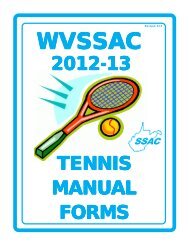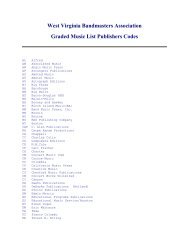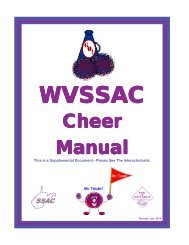Adjudication of Music Groups - wvssac
Adjudication of Music Groups - wvssac
Adjudication of Music Groups - wvssac
You also want an ePaper? Increase the reach of your titles
YUMPU automatically turns print PDFs into web optimized ePapers that Google loves.
ADJUDICATION OF MUSIC GROUPSThe following check list could serve as a guide for adjudicators:1. Adjudicators must acquaint themselves with standards <strong>of</strong> performance that may be expected from school groups.The entire rating plan is based on this understanding.2. All groups earning the same rating should have attained approximately the same level <strong>of</strong> performance. Inclusionwithin the same division <strong>of</strong> groups <strong>of</strong> widely varying achievements is a misuse <strong>of</strong> the rating system.3. Expected levels <strong>of</strong> achievement may vary according to the scope and location <strong>of</strong> the competition festival.4. It is essential that the adjudicator <strong>of</strong>fer criticisms which support and clarify the rating.5. Adjudicator shall communicate comment prior to posting <strong>of</strong> the ratng.RATING SYSTEMThe trend seems to be away from giving a specific number <strong>of</strong> points on various factors such as tone, intonation,technique, etc. In lieu <strong>of</strong> the point system, a letter grade <strong>of</strong> A, B, C, D, or F shall be given for each factor and used asthe criterion for the rating.RATING IThis division represents the finest conceivable performance for the event and the class <strong>of</strong> participants beingjudged: worthy <strong>of</strong> the distinction <strong>of</strong> being recognized as among the very best.While the judge might find some minor points to criticize and make some helpful suggestions for furtherimprovement, his/her comment sheet would show a preponderance <strong>of</strong> A’s for each <strong>of</strong> the categories. His/her remarkswould generally be complimentary for outstanding work.RATING IIThis rating reflects an unusual performance in many respects but not one worthy <strong>of</strong> the highest rating due to minordefects. However, it is a performance <strong>of</strong> distinctive quality.The group in this division usually shows the results <strong>of</strong> sound fundamental training, but the performance lacks thepolish and finesse necessary to qualify for Division I. In the square on the comment sheet there could be some A’s, butthere also would be some B’s. It is relatively easy for a judge to comment on such a performance because the weaknessesstand out clearly against a generally first-rate background, and suggestions can usually be focused on somethingspecific and helpful.RATING IIIThis rating is awarded for a good performance, but one that is not outstanding. The performance showsaccomplishment and marked promise, but is lacking in one or more essential qualities.This division indicates much room for improvement in many <strong>of</strong> the fundamental items listed on the adjudicator’scomment sheet. Such a comment sheet might show a few A’s, and B’s, but would show quite a few C’s. Thereprobably would not be time or space to record each error as it occurred, but the group would have some basically finequalities and there should be ample opportunities for the judge to make suggestions for general improvement in thosefundamental factors in which the performance revealed weaknesses.
RATING IVThis rating describes a performance that shows some obvious weaknesses. These may reflect handicaps in theway <strong>of</strong> instrumentation or lack <strong>of</strong> rehearsal time.This classification represents a performance that is generally weak and uncertain. There are numerous errors andthe performance reveals basic weaknesses in most <strong>of</strong> the fundamental factors listed on the score sheet. The judge’scomment sheet will show many D’s. He/She probably will not devote much space to pointing our specific errors in theworks performed. His/Her comments, however, will likely be encouraging and contain helpful suggestions forimprovement. He/She might suggest such things as a more favorable schedule to allow more regular rehearsal, moreindividual practice, or sectional rehearsals, or more careful screening <strong>of</strong> players. The judge might even make specificrecommendations for ensemble or individual studies, and exercises that would contribute to the development <strong>of</strong> aplayer or the group.RATING VThis rating indicates a performance that reveals much room for improvement. The director should check hismethods, instrumentation, etc., with those <strong>of</strong> more mature organizations.This division is rarely used even by the most critical judges. It indicates a performance in which the players revealalmost a complete lack <strong>of</strong> preparedness and understanding. In some cases this may be due to immature studentsattempting music which is far too advanced for them. In others, it may be due to an accumulation <strong>of</strong> careless and badplaying habits, which only tend to become accentuated and more noticeable as the player becomes older. The judge’scomment sheet will, <strong>of</strong> course, be filled with D’s and F’s. He/She must use a great deal <strong>of</strong> tact in his comments tosoloists or groups in these lower divisions. If there are any commendable features in the performance, they may besingled out. Perhaps there is one outstandingly good player in the group. He/She could be held up as a model.Sometimes only the stage deportment and appearance can be commented on favorable, but even this may be somecomfort.COMMENTS ONLY (N/A)This rating provides appropriate written and verbal feedback for the betterment <strong>of</strong> the performance and the programin general. Place no letter or number ratings on the <strong>Adjudication</strong> Form.je/local/band/adj <strong>of</strong> music groups















